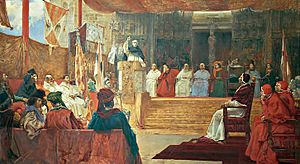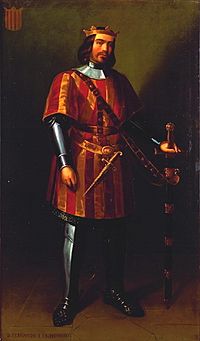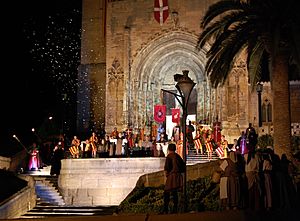Compromise of Caspe facts for kids
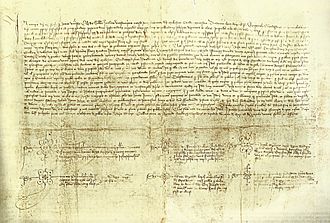
Original deed of the compromise.
|
|
| Date | 29 March - 28 June 1412 |
|---|---|
| Location | Caspe, Aragon. |
| Participants | Nine compromisaries (delegates) of the peninsular territories of the Crown of Aragon. |
| Outcome |
|
The Compromise of Caspe was a very important meeting in 1412. It brought together leaders from the different parts of the Crown of Aragon. These parts included the Kingdom of Aragon, the Kingdom of Valencia, and the Principality of Catalonia. They met in a town called Caspe.
The main goal was to choose a new king. The old king, Martin of Aragon, had died in 1410. He didn't have any children who could legally take his place. This left the kingdom without a ruler, a time known as an "interregnum." The Compromise of Caspe helped solve this big problem.
Contents
Why was a new king needed?
At that time, the rules for who became king were not very clear. They were based more on old traditions than on written laws. Usually, the oldest son would become king. If there was no son, then a younger brother or even a daughter might take over.
However, there were also ideas that male relatives from the father's side should be chosen first. This made it tricky to decide who should be the next ruler. Many people had different ideas about who had the best claim to the throne. It became a political problem, not just a legal one. People wanted to choose the best leader for the kingdom.
Who wanted to be king?
Several important people believed they should be the next king. Here are the main candidates:
- James II, Count of Urgell: He was the closest male relative to King Martin through the father's side. He was also King Martin's brother-in-law. James felt he should be king because of his family line.
- Louis of Anjou: He was King Martin's grand-nephew through the mother's side. He claimed the throne because he was a direct descendant, even if through a female line.
- Alfonso I, Duke of Gandia: He was an older relative of the royal family. He claimed the throne based on being the oldest male in the family line. He passed away in March 1412.
- John of Ribagorza: He was Alfonso's brother and took over his claim after Alfonso died.
- Ferdinand of Castile: He was King Martin's nephew. He was also the regent (a temporary ruler) of Castile and had a strong army. He claimed the throne because he was closely related to the last king.
- Frederic, Count of Luna: He was King Martin's grandson, but he was born outside of marriage. He had been made legitimate by the Pope at the time.
Royal family connections
This family tree shows how the main candidates were related to the kings of Aragon:
The time without a king (1410–1412)
Everyone agreed that a special meeting of the cortes (parliaments) was needed. But it was hard to get the parliaments of Aragon, Valencia, and Catalonia to agree. They all had different ideas.
The situation became very tense and even violent. A supporter of James II of Urgell, Antón de Luna, killed the Archbishop of Zaragoza. This event hurt James of Urgell's chances. It helped Ferdinand of Castile, who had an army nearby.
There was fighting in the streets, especially between supporters of Aragon and Valencia. The Kingdom of Aragon was split. Two different parliaments met: one for Ferdinand in Alcañiz and another for James in Mequinenza. The same thing happened in Valencia. Ferdinand's troops even entered Aragon and Valencia to fight James's supporters. A big battle in February 1412, the Battle of Morvedre, gave Valencia to Ferdinand's side.
How the decision was made
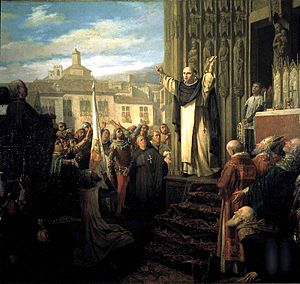
The Pope at the time, Pope Benedict XIII, suggested a smaller group. This group would have nine "compromisarios" (negotiators). The parliament in Alcañiz, which supported Ferdinand, agreed. This led to an agreement called the Alcañiz Concord in February 1412.
However, the Alcañiz parliament then chose all nine negotiators themselves. This made the Catalan and Valencian leaders very angry. They felt it was unfair and ignored their wishes for peaceful talks. James of Urgell and Louis of Anjou also complained.
The chosen negotiators met in Caspe to pick the new king. Most historians agree with the story told by Jerónimo Zurita. He wrote his history from original records, which are now lost. According to Zurita, the negotiators had different opinions. They voted on June 24, 1412.
Here's how the delegates voted:
Delegates from the Kingdom of Aragon:
- Domènec Ram (Bishop of Huesca): Voted for Ferdinand of Castile.
- Francesc de Aranda (royal advisor): Voted for Ferdinand of Castile.
- Berenguer de Bardaixí (lawyer): Voted for Ferdinand of Castile.
Delegates from the Kingdom of Valencia:
- Vicent Ferrer (a famous friar): Voted for Ferdinand of Castile.
- Bonifaci Ferrer (Vicent's brother): Voted for Ferdinand of Castile.
- Pere Bertran (legal expert): Did not vote for anyone.
Delegates from the Principality of Catalonia:
- Pere de Sagarriga i de Pau (Archbishop of Tarragona): Voted for James of Urgell.
- Bernat de Gualbes (councillor of Barcelona): Voted for Ferdinand of Castile.
- Guillem de Vallseca (officer of the Catalan Parliament): Voted for James of Urgell.
On June 28, 1412, Ferdinand of Castile was officially announced as the new king. Vicent Ferrer made the public speech.
Different ideas about the vote
Recently, some historians have questioned Zurita's account. They say there's no proof of a secret vote. They believe all nine negotiators agreed on Ferdinand unanimously. Their main point is that the official document announcing the king doesn't mention any vote results. They also say that some people present at the announcement claimed everyone agreed.
However, other historians disagree. They point out that in such elections, like choosing a Pope, vote results are often not made public. This doesn't mean the vote was unanimous. They also mention that even Ferdinand's own historian in the 15th century said there were different opinions among the negotiators. Other writers from the 17th century also saw the same documents as Zurita and reported the same voting details.
What happened next?
At first, James II of Urgell accepted the decision. He even promised to be loyal to the new king. But in May 1413, he started a rebellion. He tried to get more nobles to join him, but he wasn't very successful. There were some small uprisings in Valencia and Catalonia. James himself led attacks from his area in Urgell.
James's supporters were defeated in a battle near Lleida in June 1413. Antón de Luna tried to help James by bringing in troops from France and England. But they were defeated before they could join James's army.
In August, Ferdinand began to surround James's city, Balaguer. Antón de Luna tried to defend Huesca, but his castle was taken. He and his troops fled. Finally, in October 1413, James surrendered at Balaguer. The rebellion ended in January 1414. The County of Urgell was then taken over by the king. Its lands were given to those who supported Ferdinand.
With Ferdinand of Castile becoming king, the Crown of Aragon became more connected to the powerful Crown of Castile. About 50 years later, Ferdinand's grandson, Ferdinand II, married Queen Isabella of Castile. This marriage joined the two kingdoms, which eventually led to the creation of modern Spain.
See also
 In Spanish: Compromiso de Caspe para niños
In Spanish: Compromiso de Caspe para niños
- La fi del comte d'Urgell, a book supporting James of Urgell's claim.


